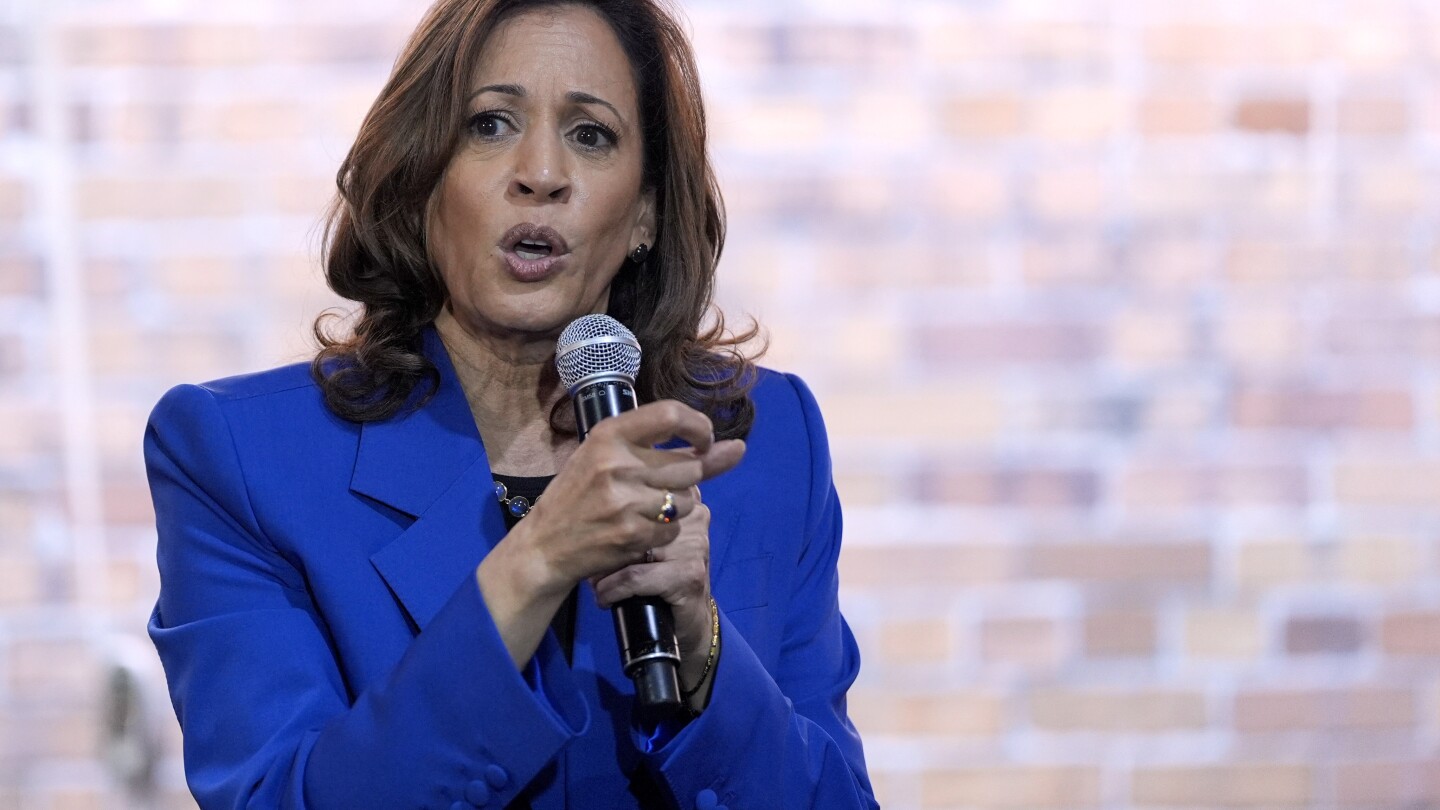Kamala Harris has a new advertising push to draw attention to her plan to build 3 million new homes over four years, a move designed to contain inflationary pressures that also draws a sharp contrast to Republican Donald Trump’s approach.
Harris, the Democratic nominee for president, highlights her plan in a new minute-long ad that uses her personal experience, growing up in rental housing while her mother had saved for a decade before she could buy a home. The ad targets voters in the swing states including Arizona and Nevada. Campaign surrogates are also holding 20 events this week focused on housing issues.
In addition to increasing home construction, Harris is proposing the government provide as much as $25,000 in assistance to first-time buyers. That message carries weight at this moment as housing costs have kept upward pressure on the consumer price index. Shelter costs are up 5.1% over the past 12 months, compared to overall inflation being 2.9%, according to the Bureau of Labor Statistics.
“Vice President Harris knows we need to do more to address our housing crisis, that’s why she has a plan to end the housing shortage” and will crack down on “corporate landlords and Wall Street banks hiking up rents and housing costs,” said Dan Kanninen, the campaign’s battleground states director.
Let’s ban corporations from owning residential property. It makes zero sense.
thatd take actual political will instead
Keep repeating it and see what happens.
It will not fix anything. There are plenty of homes already. Corporate greed is the cause of the housing crisis. There needs to be legislation that makes it unprofitable to own and hold unused properties
Supply is absolutely an issue! Many cities have growing populations. Empty homes in the sticks aren’t doing us any favors.
Where? In my area as soon as they announce a new development a few weeks later they have a sign that says “lasts houses left” and a few after that they remove the sale sign
These are giant ranch houses too, we need lots of small and medium houses
Are those houses then listed as corporate rentals? Because that’s super common.
There are plenty of homes already.
Plenty of homes where? In my city, which is a major job center, there are hardly any houses for sale. It doesn’t really matter if there are plenty of houses 1+ hours away from my job.
How many of the 3 million houses will be built in your area and what impact do you think they will have?
The problems that are causing the crisis are corporate greed and Airbnb-esque rentals.
Are you looking to fight the symptoms or the cause?
Edit: I live in a major city and there is plenty of housing, just not affordable
I live in a small city outside a major city. I do not know what Harris plans but I have hope for a recent state law encouraging multi-family housing near transit. We do have a train station at the center of town that’s also a bus hub and a great walkable area with shops and restaurants. We already have larger condo and apartment buildings here, and more of those are our best hope to affordability. While those new places won’t be affordable, all the surrounding older three deckers should drop in price, with increased supply
Going from suburban to urban was a major quality of life upgrade for me. It still blows my mind how much safer cycling is in the city than in suburbia. I’m hoping the 15min city idea gains momentum because it’s such a better use of space. Transit and micromobility initiatives would be a great thing to hear more about from Harris.
In my city, there’s hundreds of empty homes for sale, valued at 250k-500k more than what they were a decade ago.
The houses an hour away in the burbs are all in the middle of nowhere, supported by stripmalls and a single big box store. Those houses are also the same price.
Hardly any houses for sale doesn’t mean there aren’t plenty of empty houses available. They’re just fucking bought up by corpos to sit on as investments or for rentals.
Have you checked to see how many AirBNB houses you have in your area? There are over a thousand in the area where I live. Of course, AirBNB knows how bad the real number would make them look, so they obfuscate it, but every AirBNB listing can represent a house where a couple might get started. But why sell a home at even 400k when you can rent every room in that house for $250 a night. $250 * 3 (Bedrooms) * 7 * 52 = 273k a year to START, and that number keeps going up and up and up…
There are 258 million adults and 144 million homes in the US. Even if vacant housing is reduced to 0, there’s still not enough housing.
Aren’t the homes designed for more than 1 person each?
Sure, people sharing housing, but 36 million people live alone. How many more would live alone if they could?
It’s such a complex problem, it’s going to take a long time to fix. Part of the problem is people don’t really understand what the real problem is. They think the problem is that there aren’t enough detached, single family homes being built. I get why people would focus on single family homes because that’s what Americans want. The “American Dream” is to own your own home in the suburbs, and if you think that everyone who wants a single family home should be able to buy one, then, yeah, you’re going to see the problem as one of not enough single family homes being built. However, I would argue that the American dream itself is the problem.
Suburbs are expensive, and inefficient, bad for the environment, and bad for our physical and mental health. Suburbs necessitate car dependence, and cars themselves require a lot of expensive infrastructure. I know a lot of Americans don’t like to hear it, but we really do need to be living in higher density urban areas. Higher density, mixed use urban areas allow people to walk and bike more, which is better for our health. It’s also less expensive. The farther apart everything is, the more you’ll need to drive, and that means owning your own car, which is expensive.
I don’t think people even necessarily know why they want a single family home. I think Americans want single family homes because we’re told from day one that is what we should want. It’s our culture. You grow up, get married, buy a home in the suburbs, and start a family. You own at least two cars, you drive everywhere, that’s the American dream. I think we need to start questioning if this is really what’s best, and if we should really want it. I know I have, and I’ve decided it isn’t best. I think I would be happier and healthier living in a mixed use urban area, where I could walk or bike to a lot of places, or take public transportation, and if I needed to drive somewhere, maybe I’d take a taxi or rent a car or use some car sharing service.
Very few places like these exist in the US, and that’s because too many people still want to live in a single family home in the suburbs, and many of those people, also have most of their personal wealth in their home, so they push for restrictive zoning laws and other regulations, limiting how much higher density housing and mixed development can be built, thus making such areas relatively rare and thus expensive. There’s a battle going on between people who want single family homes and people who want higher density, mixed use areas.
I know people don’t want to talk about that, because they don’t want to make it an us vs them thing, but it just is. Our desires are mutually exclusive, due to the finite nature of land. A given piece of land cannot be both a low density, single family suburb and a higher density, mixed use area, simultaneously. It must be one or the other. How we “fix” the housing crisis depends on which we choose to prioritize. We either find ways to build more and more suburbs, or we eliminate single family zoning and invest in building many more, higher density, mixed use urban areas. I know which one I choose.
3 million homes
Not happening. She’s trying to win the votes by implying she can reduce prices of homes, but she knows this won’t happen. She lies into your faces
So you’re saying that supply will not change cost?
No, I’m saying there will be no more supply than it is now. She ain’t building these homes
The government uses incentive for builders and land owners to build certain types of projects. For instance, there are incentives for them to build low cost senior housing at fixed end cost. This is no different.
Government incentives don’t decrease price of anything. If you want to buy a car with price tag of 100k and your good friend pays 30k for you so you pay just 70k, that doesn’t make car any cheaper. It still costs 100k.
Same with housing.
just like the factories that get tax breaks because they hire people does not translate to people making living wages
So 3 million more abandoned homes. Got it. Can’t wait.
increasing stock does not mean prices will magically go down and cool the inflation
living wages, pushing for fixed mortgage rates, pushing for nondiscriminatory banking policies nationwide, increasing the education budget are things that do that
increasing the number of overpriced houses instead of fighting for the people to have living wages is not helping
and all these homes would require the roads to be torn up and repiped
where is that budget? is places like Flint going to finally get the nonlead pipes?
logistics were not expanded on in the article
what about the already over stressed water table here in the US?
impact studies seem to be a thing of the past when it comes to new construction
even the article linked in the article mentions nothing about anything that would actually go towards solving the issues at hand
and in this statement
In her speech, Harris offered stark contrasts with Trump’s economic proposals, including his call for steep tariffs on foreign goods. She said that her opponent “wants to impose what is, in effect, a national sales tax on everyday products and basic necessities that we import from other countries.”
Biden and Harris has been doing steep tariffs that amount to more the citizens have to pay for goods
every election cycle makes it more obvious that neither party have our interests at heart
increasing stock does not mean prices will magically go down
Actually, it does.
living wages, pushing for fixed mortgage rates, pushing for nondiscriminatory banking policies nationwideo, increasing the education budget are things that do that
All of which are also in policy proposal
and all these homes would require the roads to be torn up and repiped
To be offset by additional tax base.
is places like Flint going to finally get the nonlead pipes
Flint is covered by the Infrastructure Act
Flint needed help a decade ago and still does
https://www.britannica.com/event/Flint-water-crisis
Flint water crisis, human-made public health crisis (April 2014–June 2016) involving the municipal water supply system of Flint, Michigan. Tens of thousands of Flint residents were exposed to dangerous levels of lead, and outbreaks of Legionnaire disease killed at least 12 people and sickened dozens more.
https://truthout.org/articles/the-2024-presidential-election-may-slow-plans-to-replace-lead-pipes/
The proposal from the Biden administration builds on different rules put out in the waning days of the Trump term that allowed up to 30 years for service line replacement, triggered only when lead levels test higher than 15 parts per billion. The new proposal, which would largely supplant the Trump rules, calls for stricter monitoring, enhanced public education, and the 10-year pipe replacement mandate regardless of lead levels.
An October deadline looms for the new rules to be adopted; otherwise, enforcement of the less-stringent Trump administration rules will begin. And complicating matters more: November’s election results could shake up whose rules the nation must follow.
While many cities and states have begun to replace their lead pipes, some utilities and officials say the 10-year time frame is unfeasible and too expensive. They say it would be difficult for water utilities to follow the rules while dealing with new EPA limits on five PFAS contaminants, known as “forever chemicals,” and failing pipes, among other issues.
The Infrastructure Act has provision for eliminating iron piping from US city water supply. It was passed a year ago. In a place as big as Flint, it’s a big F’n job. It took years to put in the system and it will take years to replace it. I’m sure Big Gretch has eyes on.
just like raising the minimum wage was talked about a decade ago too
both parties are paid too much by the MegaCorps to pass anything that would help
Wealth tax is the answer to “where will the money come from”
I appreciate the optimism, but who is going to pass a wealth tax?
The American public?
Lol










